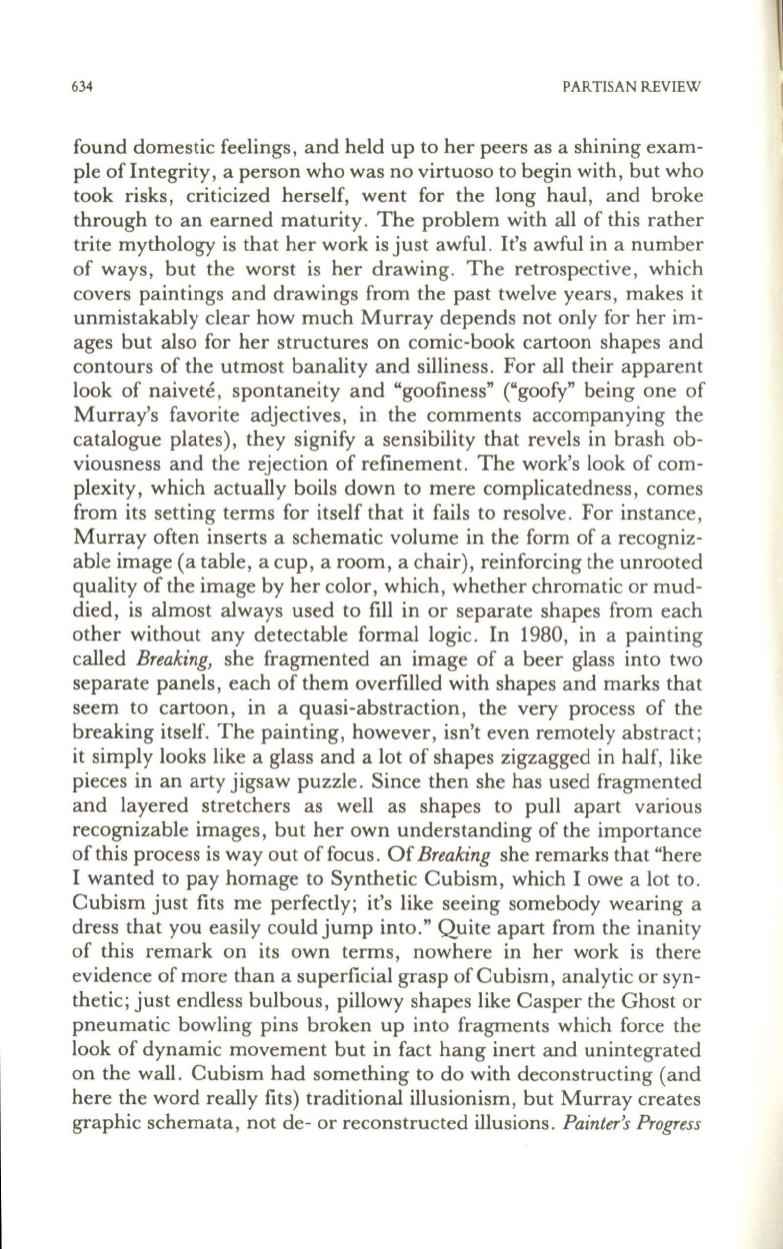
634
PARTISAN REVIEW
found domestic feelings, and held up to her peers as a shining exam–
ple of Integrity, a person who was no virtuoso to begin with, but who
took risks, criticized herself, went for the long haul, and broke
through to an earned maturity . The problem with all of this rather
trite mythology is that her work is just awful. It's awful in a number
of ways , but the worst is her drawing. The retrospective, which
covers paintings and drawings from the past twelve years , makes it
unmistakably clear how much Murray depends not only for her im–
ages but also for her structures on comic-book cartoon shapes and
contours of the utmost banality and silliness. For all their apparent
look of naivete , spontaneity and "goofiness" ("goofy" being one of
Murray's favorite adjectives, in the comments accompanying the
catalogue plates), they signify a sensibility that revels in brash ob–
viousness and the rejection of refinement . The work's look of com–
plexity, which actually boils down to mere complicatedness, comes
from its setting terms for itself that it fails to resolve . For instance ,
Murray often inserts a schematic volume in the form of a recogniz–
able image (a table, a cup, a room, a chair), reinforcing the unrooted
quality of the image by her color, which , whether chromatic or mud–
died, is almost always used to fill in or separate shapes from each
other without any detectable formal logic . In 1980, in a painting
called
Breaking,
she fragmented an image of a beer glass into two
separate panels, each of them overfilled with shapes and marks that
seem to cartoon, in a quasi-abstraction, the very process of the
breaking itself. The painting, however, isn't even remotely abstract ;
it simply looks like a glass and a lot of shapes zigzagged in half, like
pieces in an arty jigsaw puzzle. Since then she has used fragmented
and layered stretchers as well as shapes to pull apart various
recognizable images, but her own understanding of the importance
of this process is way out offocus . Of
Breaking
she remarks that "here
I wanted to pay homage to Synthetic Cubism, which I owe a lot to .
Cubism just fits me perfectly; it's like seeing somebody wearing a
dress that you easily could jump into." Quite apart from the inanity
of this remark on its own terms, nowhere in her work is there
evidence of more than a superficial grasp of Cubism, analytic or syn–
thetic; just endless bulbous , pillowy shapes like Casper the Ghost or
pneumatic bowling pins broken up into fragments which force the
look of dynamic movement but in fact hang inert and unintegrated
on the wall. Cubism had something to do with deconstructing (and
here the word really fits) traditional illusionism, but Murray creates
graphic schemata , not de- or reconstructed illusions .
Painter's Progress


